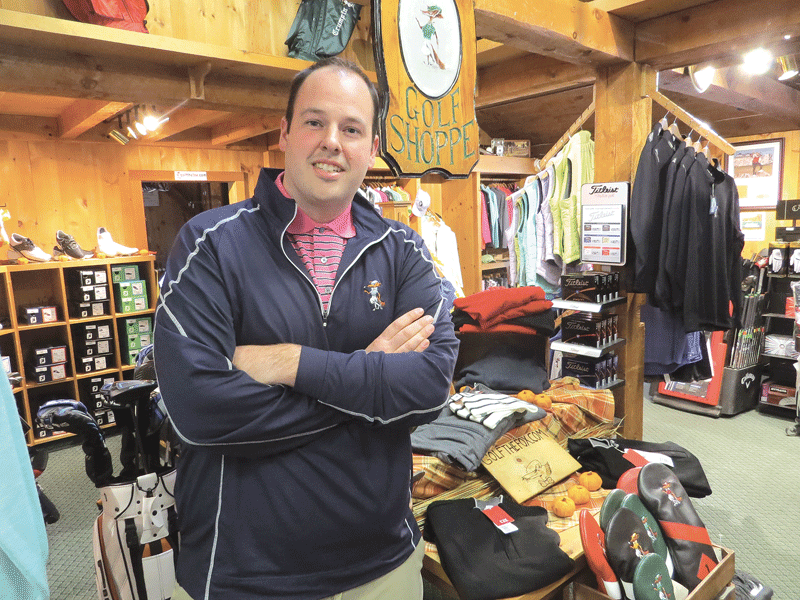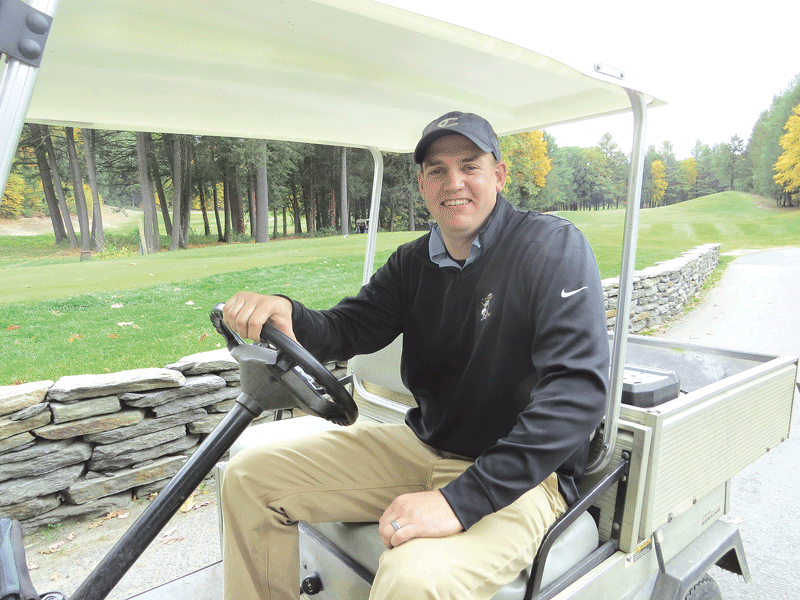
Crumpin-Fox Owners Undertake Ambitious Investments
Course of Action

Tim Van Epps, seen here with the famous wooden fox positioned near the clubhouse, says the Sandri companies are “all in on golf.”
Tim Van Epps calls it the “race to the bottom.”
That was he was colorful way of describing the sum of what’s happening in the golfing industry, at least the public-access side of the equation. And maybe the private side, too.
Elaborating, he said that, in the face of a host of factors that have negatively impacted the golf business — everything from lingering effects from the recession to declining interest among younger generations to oversaturation of this region with courses — owners and operators have responded with gimmicks, special rates, and an inclination to cut corners, defer maintenance, and, in the process, jeopardize quality until fiscal conditions improve.
“It’s a tough industry now,” said Van Epps, president and CEO for the Sandri Companies, which has a number of business divisions, including golf. “During the boom days, the late ’90s and early 2000s, if you opened a course, people would come. It’s not like that now. You saw thousands of courses open across the country, flooding the market with opportunities for people to play. And then, the market crashed, and now you’re seeing more courses close in a year than new ones open. And most courses are just trying to get by.”
But Sandri is taking a much different approach to these challenging times. Indeed, rather than hunker down and join others in that race to the bottom, Sandri is going to make significant investments in its Crumpin-Fox layout in Bernardston, and instead commence a race to the top.
That would be the top of the list of golf courses in this region, he said, noting that there are, in fact, several such compilations, and the one he’s most interested in is Golf Digest’s list of the best courses in Massachusetts that anyone can play. (Private clubs are, by their very nature, courses that only members can play.)
To that end, the semi-private club is commencing what will likely be north of $5 million in improvements, everything from dramatic, yet strategic, thinning and clearing of the trees that line most fairways, to paving of the cart paths; from a new pavilion at the 19th hole (a.k.a.) Zeke’s Bar & Grill, to renovation of the bunkers; from a huge facelift for the practice area, to some aggressive pricing programs.
The immediate goal of all this work is to make the course more accessible, playable, and enjoyable, said John (Boo) Jackson, director of Golf for Sandri, who said all these initiatives come together in something the company is calling a ‘grow-the-game campaign.’
“We’re trying to get some younger faces out here,” he said, zeroing in one of the biggest challenges facing course owners today, “and infuse this place with energy, enthusiasm, and a just a welcoming attitude and approach.”
As just one example, he cited a Franklin County resident’s rate, which, as that name suggests, provides discounted greens fees ($45) to area residents, many of whom are mistakenly of the belief that this is either not a public-access course, or it is public, but way too expensive.

John (Boo) Jackson says a ‘grow-the-game’ campaign at Crumpin-Fox is aimed at generating enthusiasm and maximizing the “experience.”
Meanwhile, children of those residents who are 12 and under can play for free, he went on, adding that growing the game is difficult given the current conditions, but doable if an operation can blend imagination with solid customer service and that welcoming attitude he described.
Overall, the aim is to grow all aspects of the business, meaning golf, outings, weddings, and more, including indoor golf (simulators) and even snowshoeing and cross-country skiing, said Van Epps, adding that steps taken recently under the grow-the-game umbrella triggered a solid second half to the 2016 season and solid optimism for next season and well beyond.
“We’re all in on golf,” he explained. “We’ve seen an incredible lift in the second half in rounds — and in the excitement that our golfers are experiencing. We’re getting a lot of first-timers, and overall, there’s been an energy surge here.”
For this issue, BusinessWest takes an indepth look at what’s happening at Crumpin-Fox, and, more importantly, why these investments are being made, and how this course of action can wind up changing the landscape in many ways.
Round Numbers
If you were paying attention — make that really paying attention — to golf equipment maker TaylorMade’s commercials aired during July’s PGA Championship and featuring Jason Day, you would have noticed that Crumpin-Fox was sharing the stage with the world’s number-one player.
Actually, several courses did, in an almost-subliminal way. The commercial is about planning and executing the many shots golf requires players to hit, and as he’s thinking about some of them — a high fade or a low cut, for example — Day, the defending PGA champion at the time, is picturing golf holes that require such execution. In addition to holes at Whistling Straits (where Day won the PGA in 2015), Chambers Bay (site of the 2015 U.S. Open), and others, the sixth, seventh, and eighth holes at Crumpin-Fox, the most famous and photogenic stretch on the course, makes an ever-so-brief, one-second cameo.
“The folks at TaylorMade were up here recently getting some drone footage of the course,” Van Epps explained. “They were round-tabling it, looking over footage of all these courses for the commercial, and the brass at TaylorMade came across Crumpin-Fox and said, ‘holy moly, this one of the most beautiful courses we’ve ever seen.’ And that’s how we wound up in the commercial.
“And people noticed,” he went on. “Even though it’s just a second or so, people who’ve played here could recognize those holes.”
The goal moving forward is to make Crumpin-Fox, well, front of mind, not for PGA professionals, necessarily, but for players who might already have played it, and those who have perhaps thought about it, but have yet to program ‘Parmenter Road, Bernardston, Mass.’ into their car’s GPS.

Scott Gilmore says an aggressive tree-clearing and trimming project will make Crumpin-Fox more playable — and enjoyable.
‘The Crump,’ as it’s sometimes called, or ‘the Fox’ (another alias), has always been a popular destination since the original nine-hole track, designed by Roger Rulewich, was expanded to 18 holes in 1977, and business has been steady even in the difficult times of recent years, said Jackson.
But the goal of any business, even those in the golf industry at this challenging time, is to grow, said Sandri, adding that, unlike those competing (if that’s the word for it) in the race to the bottom, he wants to travel in the other direction. And storming to the top of the ‘best courses you can play’ list is merely one of the goals, albeit one with great significance when it comes to reaching the broader goal — to get more people to make that scenic drive down Parmenter Road, an assignment that has a number of components. They include:
• Making the course more playable, as noted earlier, by undertaking some much-needed maintenance and tree work;
• Upgrading facilities to improve play and the overall customer experience. Replacing dirt cart paths with paved routes definitely falls into this category, as do improvements to bunkers and tee boxes;
• Those special rates for young people. Special as in free to those under 12, an ambitious initiative designed to inspire younger generations to take up the game and become acquainted with, and probably enamored with, the Fox; and
• Greatly enlarging and improving the 19th hole and banquet areas, as well as the practice area — two of many steps being taken to generate more and longer stays at Crumpin-Fox.
Drive to the Top
Work on all this is already underway, and will greatly accelerate in the weeks to come, said Van Epps, adding that the course will close at the end of the month — just a few weeks ahead of the normal schedule — so crews can get to work.
A big focus early will be on tree trimming and clearing, said Course Superintendent Scott Gilmore, who is not a forester, or a golf-course designer, but can talk expertly on why taking trees down is not a bad thing — for the course, those who play it (that should be obvious), wildlife, or society in general.
“After 40 years, the trees are getting big, and they’re causing some problems,” he explained, noting that more than 5,000 or so will be taken down, and others will be cut back. “We need to push them back and give people the holes back.”
Indeed, much of the tree work has been long overdue, said Van Epps, noting that encroachment has impacted everything from shot selection to convenience.
“There are two fountains on the sixth hole that are now 12 feet into the woods,” he explained. “When we first opened, you could walk right up to those and get a drink of water; now, the deer are enjoying them.”
To get these points across, Gilmore pointed to the last 200 or so yards of the rugged par-4 18th hole, or that portion that can be seen off the back deck of Zeke’s.
There, trees are encroaching on the fairways, blocking great views of players coming down the final fairway (the Crump has hosted a number of tournaments over the years and has more, including a sectional qualifier for the U.S. Open, on the books for the coming years), and unnecessarily and even unfairly getting in the way of golf shots.
And the 18th is typical, he went on, adding that there are many holes where trees are too dense, too tight to the fairways, and overgrown to the point where they make shots more difficult than they should be given the original designs.
But the dense vegetation brings other problems as well, said Jackson, noting that, in the heavy underbrush and tightness of the fairways, one could easily lose a sleeve of balls (or two, or three, or four) playing 18 holes, which is expensive. Thus, players search hard for a ball before digging into the bag for another one, slowing the pace of play.
Eliminating and thinning trees brings many benefits, said Jackson, and they add up making the course more playable and enjoyable, which in turn leads to repeat business and positive testimonials.
But while golf is the main focus of the Sandri investments, the broader assignment is to make this more of a year-round destination, said Van Epps, and a growth business, like the many energy-related divisions of the corporation.
To that end, Crumpin-Fox is adding indoor golf simulators, and also laying track for a snowshoeing operation, one that will capitalize on an activity rapidly growing in popularity, especially among Baby Boomers searching for enjoyable, calorie-burning, outdoor activities.
“We have trails going in all throughout the course, and that presents options for a visit to Crumpin-Fox,” he explained. “If a couple comes up, and the husband likes to snowshoe and the wife likes to golf, he can rent some shoes, and she can play on the simulator.”
Longer-term plans call for building a lodge on the edge of the property, he went on, adding that the goal is to make Crumpin-Fox a true destination, and not just for those who wear hats that say ‘Titleist.’
Pinning Their Hopes
Looking over the golf landscape, Jackson theorized that many in the industry have used the economy as an excuse for falling play and declining revenues.
With more introspection, he surmised, they would see that fair to poor customer service, coupled with what he calls an unwelcoming attitude, has contributed to, and perhaps been the main culprit in, the current challenging times.
The Crump takes a different attitude in all respects, he said, adding that this is one of the many ways in which the club is setting itself apart.
While most of the rest of the industry is in a race to the bottom, the Sandri operation is driving for the top. It’s an aggressive, expensive course of action, but one that all those involved believe will pay dividends down the road — or down the fairway, as the case may be.
George O’Brien can be reached at [email protected]





